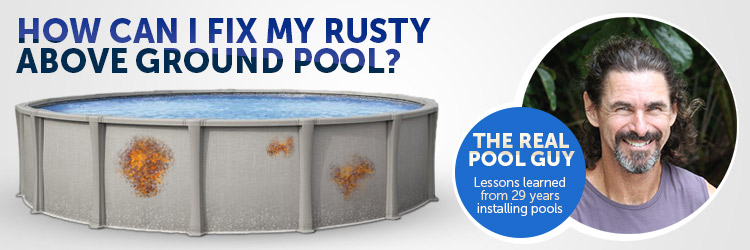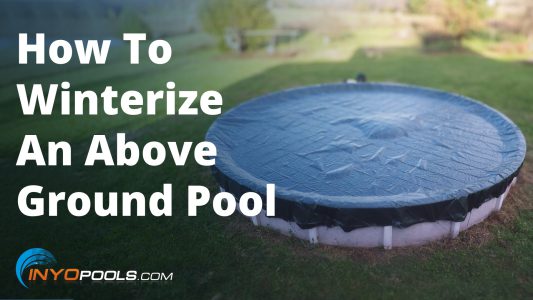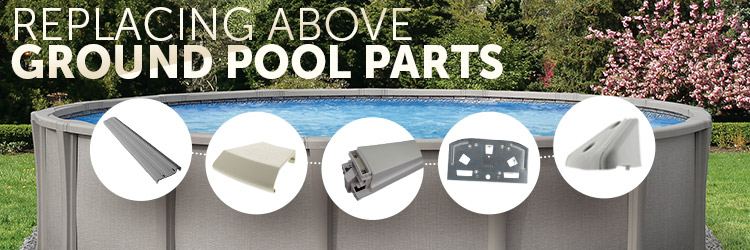I have observed over three decades that the average decent quality above ground swimming pool lasts between 10 and 20 years. Sometimes pool owners will replace their pool because its top rails are too rusty or some of the uprights and pieces of bottom track have rusted out. Mostly though, people decide that their pool is dead because it has a rusty or corroded wall. And this is what makes an above ground pool no good anymore as it’s the wall that holds all the water.
Most of the time, a rusty pool wall is noticed when a liner is changed. The pool gets drained and then the existing liner is removed which exposes the interior wall. A sinking feeling is experienced when you see that the interior wall is rusty. You’ve already bought a pricey replacement liner. You start to ask yourself, “Is this normal? How bad is it? Can I fix this? How do I fix this?” As you climb out of the pool to go look for that can of Rust-Oleum you bought two years ago, you wonder how bad this rusty wall really is and instead go search on the Internet.

You’re Going to Have to Do Some Poking Around
This blog post is about advanced wall repair for above ground pools, but before I can tell you about that you must find out if you need it. Most of the time the discovered rust on the inside of the pool wall is just surface rust and not much of an issue. With surface rust you can maybe get some sandpaper, sand the rusty areas smooth, and then use that can of Rust-Oleum you found and the wall is good to go.
What if it’s more than just surface rust? Maybe the rust is falling off in small pieces and looks pretty bad and deep. What’s important here is the wall’s integrity. The wall of an above ground pool wall has to hold thousands of pounds of water so if the rust has eaten its way deep into the steel or aluminum, it may no longer be strong enough to hold the water. A wall can look pretty bad and still be fine, but if there are spots where it has rusted all the way through then that is bad and cause for alarm. To find out, take a medium-sized screwdriver and poke at the rust. Scrape off any loose pieces of rust and firmly poke those areas. If the screwdriver pokes completely through the wall, then that’s not good. It may not be the end, but it’s not good.
Some Holes Are Worse Than Others
So you’ve poked around the rust and the screwdriver went all the way through in a couple of spots. That’s always bad, but you may still be OK. A small rust hole that’s located high up the pool’s wall is usually alright.In that case I will cut a small square of roofing tin or some kind of sheet metal and use duct tape to secure it in place over

the area. I do this only to protect the new liner I’m about to install from the rust as this repair adds no strength to the wall.
If the rust holes are closer to the bottom of the pool’s wall, then that’s worse and should possibly require more than just a simple patch job. The reason a hole lower down is concerning is because the water creates more outward pressure there at the bottom. A rust hole at the bottom of the wall is much more likely to tear open under pressure and cause a “blowout” than one nearer to the top. In most cases a small hole towards the bottom of the wall won’t cause a blowout. I usually tell the pool owner about it, tape some tin over it, install a new liner and it holds. Though, there is always the possibility that it won’t hold and I leave the decision up to them. I’ll show them the concerning rusted area, give them the odds of whether I think it’ll hold or not, and let them tell me either to proceed with the change of the liner or wait and get it repaired. Worst-case Scenario
Worst-case Scenario
It has come down to this. Let’s say you have a lot of rust toward the bottom of your pool wall and it has rusted all the way through. What now? Well, there are three options at this point. You can tape over the rusty areas with some kind of sheet metal, install a new liner, fill the pool back up and hope for the best. This is a viable option for many as they have already purchased a replacement liner and don’t have the money for a new pool. Many times this is the best decision for them as the wall holds up and they get to have their pool. Though, with this option, you may not be so lucky, because if it doesn’t hold, you’re out the cost of the new liner, the installer (if you didn’t do it yourself), and all the lost water and chemicals.
The second option is not to take the chance and get a whole new wall. Or at least that’ll be what you think you’ll do until you try to find a replacement wall. It’s not easy to get just a replacement wall for an above ground pool as manufacturers don’t like to provide them for models which are more than a couple of years old. That’s OK though as you would soon find out, because if you do get lucky and find a replacement wall it’ll be way expensive. At that point in the story, people usually opt to get a whole new pool as the price is just slightly more than for just a wall.
The third option is to repair the wall. This is rarely done, though. The reason for this is not because it’s too expensive, looks bad, or doesn’t hold. Repairing a rusty above ground pool wall is rarely done, because there are not many people who know how to do it. Over the years I have learned by way of trial and error that there is only one true way to repair a wall and that is to add a new piece of wall from top to bottom.

The Only Guaranteed Way to Repair a Rusty Wall
Over the years I’ve tried to repair damaged pool walls in many ways. It was easy to experiment as people facing an apparent pool replacement would take a chance on my repair. I started by just duct taping some rigid steel sheeting over the holes and some failed. Then I would bolt the pieces of sheet metal to the existing wall all the way around the rust holes. Some failed. Then I tucked bigger pieces of sheet metal into the pool’s bottom track and upward to cover the holes and bolted them. Still some fails.
I finally realized that I needed to reinforce the damaged wall’s integrity from top to bottom and not just in the local bad spots. So, this is what has to be done:
- Get an entire piece of above ground pool wall.
This may be the hardest part of the above ground pool repair for the do-it-yourselfer. The two ways to get an entire piece of pool wall are from an old pool that has been taken down or by buying a piece from a pool maker. The wall piece should be at least 4’ long or long enough to cover all the bad areas of your pool wall.
- Get at least 30 stainless flathead steel bolts and nuts and four pieces of metal steel channel.
You’ll use these to bolt your new piece of wall to your existing pool wall.
- Place the new wall piece against the pool’s wall on the inside.
You’ll have to move away the bottom cove in that area so the wall piece can fit right up against the existing wall from top to bottom.
- Line up the metal channels to the edge of the wall piece and drill holes all the way through.
You’ll be drilling holes from the inside of the pool through the inside and outside steel channel, the wall piece, and the existing wall from top to bottom.
- Bolt everything together through the drilled holes.
Make sure the nuts and bolts are nice and tight.NOTE: If I’m not making sense here, you can look at the way the pool wall was bolted together orginally and do the same thing with this.
- Use duct tape to fasten the bolts on the inside from top to bottom.
Do it like they did with the pool’s existing wall bolts.
- Replace the coves at the bottom and you’re done.
Now you’ll have a piece of wall covering the bad place in the existing wall. And it’s bolted from top to bottom on both ends so the wall cannot split open when filled.
This is not an easy repair, but works well when done right. If you have a pool wall that has rusted away badly, my advice is to get a new pool to replace the wall and frame completely. If you don’t have the cash then try this. It may save you money, if you do it right.












I have a 52”x24’ round with a rust hole in the middle/center of the wall. Walls are not easy to find so I bought a 52”x6’ piece of stainless sheeting. Had the mill drill holes in the piece for stainless rivets per my measurements. Drained the pool one weekend and pealed back the liner just enough to fit the sheet in place, drill, rivet and duct tape the seams. Put the liner back, refill the pool. Done deal in a weekend.
What steel company did you use? This is what we need . Thanks .
I need some assistance anyone, My dad is 77 and im doing the leg work to help him. Underneath the skimmer the siding/wall panel and support beam buckled and split all the way to ground. If i could add picture i would. I am curious if something like THAT can be repaired or not. IF no, does anyone know of companies who do pool removal and new pool install in Milwaukee Wisconsin. The pool is enclosed with a large wrap around deck.
mistake, shoud have used nuts and bolts, rivets will never hold.
I have a small tear in my 15×30 wall on bottom of wall. Can it be fixed? Where can I find a wall?
Unfortunately, we do not sell above ground pool replacement walls. They are usually only replaceable through the manufacturer under a warranty claim.
We can’t really assess the severity of a pool damage without seeing it.
Not sure if you do hillard fla but I have a pool that at the bottom. It’s rusted hole to where I can see the pool liner but it’s not leaking,
where can i get an entire piece of wall 10’x48″
You would normally have to go through the manufacturer to get a wall replacement to buy or through warranty coverage. A google search of the pool manufacturer’s name with “wall replacement” should bring up some good leads.
We have a large hole at the return any suggestions/tips/ warnings on how to repair this type of hole. We will need a new liner and are looking into a new filter. The only problem with the filter is the area with the guage which leaks and now cannot seem to be fixed. Thanks for any advice..
The steps mentioned in the above article or in this guide would work for your rusty wall issue: How To Repair Rusty Pool Walls
I did all this. Took all summer and during that time all kinds off pebbles and sticks blew into my sand so now I’m sifting through all that and leveling it back out. It took more money than buying a new pool, but the pool companies wouldn’t install a new pool because I have a deck around most of the circumference. This has turned into a nightmare. And now the summer is over! I would jump off a cliff if this doesn’t work. So before I put in the liner and fill it up, I have some questions. Can we communicate directly? Through email so I can send you pictures?
I had this dilemma. In May, 2021, the guys installing my new liner discovered a small rust hole. I purchased a new pool system, minus the liner, skimmer & eyeball return (I’d already purchased a new ones to be installed with the new liner), filter, pump & motor (these were purchased new, a year ago). After much searching, I did find a company to install the new pool into the existing deck opening (it wasn’t easy). I’m in the Chicagoland area and would be happy to provide the company name. Our 15x30x52 holds 12,000 gal. Everyone I spoke with agreed we should replace our 23 yr old steel sided pool and not try to patch the hole.
Hi Sandra,
I’m in the Chicagoland area as well. Have a 22 year old pool that I’m pretty sure is shot. Where did you get you’re pool and what company did you use to install? We have a 30ft round with a deck on about a quarter of the pool.
I live in the South Suburbs of Chicago and have a 20+ year old pool with some rust holes. would you please provide the contact info for the company you used so I can contact them.
thanks!
Any thoughts on whether or not it would work to glue, heat and iron commercial rubber roofing together at the seams to create a liner? Looking for something super thick and of course, with the shortage of vinyl, unable to find a liner for our pool, rendering it useless. My wife really needs it, as she has MS and is unable to be outside without a place to cool off quickly and she also uses it to exercise to help keep the strength up in her upper & lower body
I have an 18 ft round that somehow got a smaller than a nickel size slit in the metal wall. All the rest of the pool is in excellent shape no rust . I found a guy that can repair it but my concern is the winter and the water freezing and pushing on the smalll repaired section. The hole is a half way down from pool top rails. Do you think this will cause wall failure .
Glue a metal piece on the inside of the wall to cover the slit. That way, it won’t allow it to bulge out with water pressure pushing against it. In addition to the glue, the pressure of the water against the liner and against the metal patch will allow it to hold in place